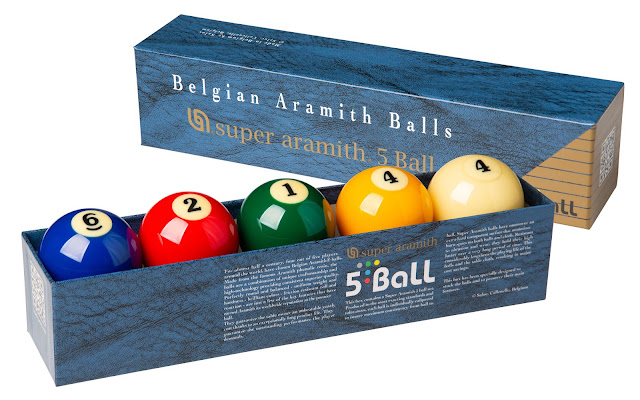It's a game that seems to have been invented by the billiard ball manufacturer Super Aramith, featuring five balls that look an awful lot like Pool balls, except there are two fours and no five:
Googling about this game yields next to no results at all, and their supposed website www.5-ball-game.com doesn't yield anything at all either.It wasn't until I stumbled upon the link 5-ball.nl I got some results!
The balls aren't sized like Pool balls at 57.15 mm (2 1/4") but instead sized like Carom balls at 61.5 mm (2 7/16"). and it's played on a pocketless Carom table.
Equipment and Setup
To play this game, you need a standard sized Carom table (the kind used for 3-Cushion and 5-Pin Billiards) and a set of 5-Ball balls.
The game is set up as such (here on a gray table to make the green ball stand out in the diagram):
The 2-ball is at the foot-end, the 6-ball is in the middle, and the 1-ball is at the head end with the two 4-balls flanking it on either side with white on the right and yellow on the left.
The white 4-ball and the yellow 4-ball are the cue-balls for each player. White for player 1 and yellow for player 2.
Rules as I understand them
First, players agree to play a number of rounds, best of 3, 5, 7, etc.
Then, players agree on a number of points to play, this could be 51, 101, 151, etc. (a multiple of 50 + 1)
The game is then played like a game of dart, points decreasing down to zero. The goal is to not overshoot the score(!)
Structure
The game is played in turns. After a player has made a shot, the other player plays their turn.
This is unlike most other billiards, where as long as a player scores, they keep playing.
The Break
To break, the white player must hit the red 2-ball. After the break, any ball on the table is free to hit.
In case the break fails, the other player simply shoots from the resulting position.
Scoring
To score the player's cue-ball must hit two or more other balls on the table.
Their values are then added together.
If the same ball is hit more than once, its value is only counted once.
Thus, it is possible to score at most 13 points in a single shot.
Note that the player's own colour is never added.
Example: Suppose White hits the blue and the green ball, then White scores 7 points. Yellow then hits white and green, scoring 10 points.
Play continues like this until someone hits exactly 0 points, at which point that player is declared the winner.
Special Cases
While there are no fouls in the game, there are nonetheless situations a player can find themselves in in which they don't make points:
- In the event that a player makes a shot that goes below 0, the shot simply doesn't count.
- If a player gets to 1, 2, or 4 points, they are then unable to win, as no shots can bring them to 0 from there. Because of this, playing a shot that gets a player to 1, 2, or 4 points counts like undershooting 0, and the player gets to stay at their previous score.
Fouls
The official rules do not list any fouls, nor any consequences as the result of any fouls.
You either made points for a shot or you didn't.
That said, reasonable fouls to include could be:
- Hitting anything other than your own cue-ball
- Hitting the cue-ball with anything other than the tip of the cue
- Not having at least one foot on the ground
A foul shot would then just invalidate any points scored for the shot.
Sources
- Official Dutch page with rules: https://www.carambole.nl/recreatie/5-ball
- This store page has a rather comprehensively translated set of rules: https://www.garlando-shop.com/en/Billiard/Balls-200937/Carom-200946/super-aramith-5-ball-carom-ball-set.html
- Archive of the old page for the game. Includes rules PDF: https://web.archive.org/web/20180724174544/http://www.saluc.com/html/billiard/index.php?idlien=47






No comments:
Post a Comment